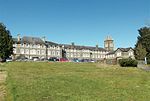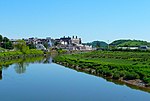Trinity University College
1848 establishments in WalesBuildings and structures in CarmarthenEducation in CarmarthenshireEducational institutions established in 1848EngvarB from November 2017 ... and 4 more
Trinity University CollegeUniversities in WalesUniversity of WalesUniversity of Wales Trinity Saint David
Trinity University College (Welsh: Coleg Prifysgol y Drindod) was a Church University College in Carmarthen, Wales. The institution was founded in 1848 as the South Wales and Monmouthshire Training College, a teacher-training college. It changed its name in 1931 to Trinity College, Carmarthen; and in 2009 to Trinity University College. In 2010, it merged with the University of Wales, Lampeter to become the new University of Wales Trinity Saint David, with the Trinity site becoming the UWTSD Carmarthen Campus.
Excerpt from the Wikipedia article Trinity University College (License: CC BY-SA 3.0, Authors).Trinity University College
Brynteg,
Geographical coordinates (GPS) Address External links Nearby Places Show on map
Geographical coordinates (GPS)
| Latitude | Longitude |
|---|---|
| N 51.8581 ° | E -4.3286 ° |
Address
Trinity College, Carmarthen (University of Wales, Trinity St. David)
Brynteg
SA31 3ES , Carmarthen
Wales, United Kingdom
Open on Google Maps








